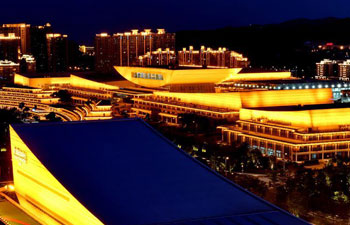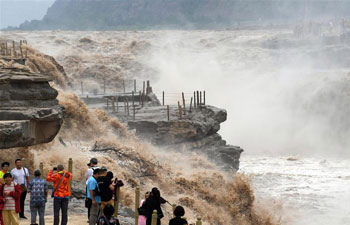SAN FRANCISCO, Sept. 4 (Xinhua) -- Researchers at Stanford University have shown that without electricity, a system involving high-tech mirror-like optical surfaces can cool flowing water to a temperature below that of the surrounding air.
Since 2013, Shanhui Fan, professor of electrical engineering, and his students and research associates have employed the roof of the Packard Electrical Engineering Building at Stanford as a testbed for the optical surface that could be the future of lower-energy air conditioning and refrigeration.
Their work published in 2014 first showed the cooling capabilities of the optical surface on its own.
Their new research, published Monday in British Journal Nature Energy, built on their previous work with what they call "radiative sky cooling" but takes it to the next level.
"It provides for the first time a high-fidelity technology demonstration of how you can use radiative sky cooling to passively cool a fluid and, in doing so, connect it with cooling systems to save electricity," said Aaswath Raman, one of Fan's former research associates and co-lead author of the latest paper.
Radiative sky cooling is a natural process resulting from the moments of molecules releasing heat, such as the heat that comes off a road as it cools after sunset. This phenomenon is particularly noticeable on a cloudless night because, without clouds, the heat can more easily make it through Earth's atmosphere, all the way to the vast, cold reaches of space.
"If you have something that is very cold -- like space -- and you can dissipate heat into it, then you can do cooling without any electricity or work. The heat just flows," explained Fan, who is senior author of the paper. "For this reason, the amount of heat flow off the Earth that goes to the universe is enormous."
Human bodies release heat through radiative cooling to both the sky and our surroundings, but radiative sky cooling isn't going to live up to its name on a hot, sunny day, as the sunlight warms us more than radiative sky cooling will cool us.
To overcome this problem, the team's surface uses a multilayer optical film that reflects about 97 percent of the sunlight while simultaneously being able to emit the surface's thermal energy through the atmosphere.
Without heat from sunlight, the radiative sky cooling effect can enable cooling below the air temperature on a sunny day.
"With this technology, we're no longer limited by what the air temperature is," noted Eli Goldstein, Fan's another former research associate and co-lead author of the paper, "we're limited by something much colder: the sky and space."
In the experiments published in 2014, small wafers about 8 inches, or 20 centimeters, in diameter were used to show how the multilayer optical surface itself cooled.
For the new paper, the researchers created a system where panels covered in the specialized optical surfaces sat atop pipes of running water. The panels were slightly more than 2 feet, or about 61 centimeters, in length on each side.
With the water moving at a relatively fast rate, the team found the panels were able to consistently reduce the temperature of the water 3 to 5 degrees Celsius below ambient air temperature over a period of three days.
Fan, Raman and Goldstein have founded SkyCool Systems, a company working on further testing and commercializing the technology, possibly by making their panels integrate easily with standard air conditioning and refrigeration systems.

















